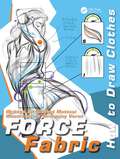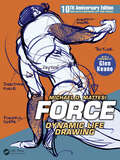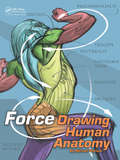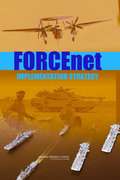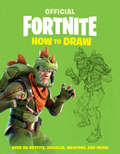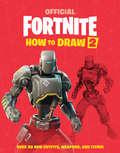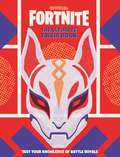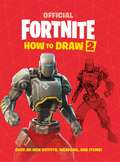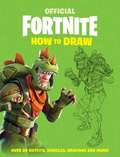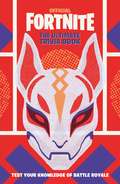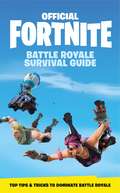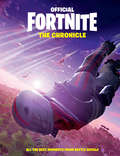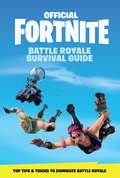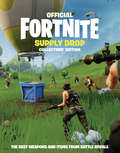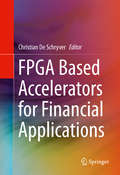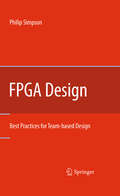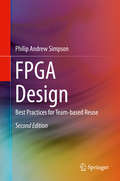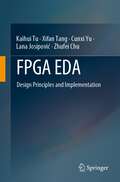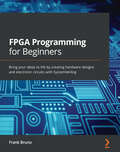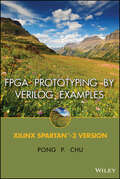- Table View
- List View
FORCE Fabric: How to Draw Clothes (Force Drawing Series)
by Mike MattesiThe nude figure defines the best way to learn the fundamentals of drawing, yet the end goal of most art presents clothed figures, be it animation, video games, film, or fine art. This sixth book in the ‘FORCE’ series instructs artists on how to understand fabric with FORCE, thus leading to improved drawings of clothed figures. Expertly organized and beautifully illustrated, the book instructs artists to see clothing in a new way, through FORCE. Michael’s clear, concise, and informal writing coupled with Mritunjay and Michael’s FORCE drawings of clothed models comprehensibly informs you, the curious artist, to identify and draw FORCE clothing. Key Features: The unique, dynamic FORCE Drawing learning system that has helped thousands of artists enhance their figure drawing abilities now brings clothing to the figure! Easy to follow fundamentals on drawing clothed figures for games, animation, film, or fine art A clear, organized, and understandable, step-by-step approach to learn about the effects of FORCE on fabric and how that pertains to drawing clothes Learn to see clothes through tight, medium, and loose-fit and discover the common fold types per category, making it easier to identify and draw A ‘sticker system’ that presents the different types of folds found in different fit types of clothing Each chapter has exercises you can use to help you learn the process of drawing clothes Find out how line can bring the texture of different fabrics to your clothing drawings Includes robust author website with further information, forums, and videos Color-coded page edges to quickly find the material you need Unlock your imagination; put the theory into practice with detailed exercises to sharpen your skills
FORCE: 10th Anniversary Edition (Force Drawing Series)
by Mike MattesiBring your artwork to life with the power of the FORCE! Watch, listen, and follow along as Mike Mattesi demonstrates the fundamental FORCE line and explains dynamic figure drawing techniques through 30 videos that are launched through the book's companion App. Packed with superb, powerfully drawn examples, the updated third edition of FORCE features an all-new section on the "FORCE blob," and dozens of fresh illustrations. Mike Mattesi’s 10th anniversary edition of FORCE will teach readers how to put thought and imagination to paper. Whether you are an illustrator, animator, comic book artist, or student, you'll learn to use rhythm, shape, and line to bring out the life in any subject. The 10th Anniversary Edition contains numerous improvements. Around 30 videos are embedded within the book and accessible through the FORCE Drawing App. In the App, click on the image of the camera, point your mobile device’s camera at the page with the symbol, and then finally tap the video card image floating above the drawing to launch the video. Then sit back and watch the video that shows me creating that drawing and discussing my process. Many new drawings can be found within this edition and the addition of color now further clarifies the theory of FORCE. Key Features The unique, dynamic learning system that has helped thousands of artists enhance their figure drawing abilities Dozens of updated illustrations and all-new content, exclusive to the 3rd edition Select pages can be scanned by your smartphone or other device to pull up bonus video content, enhancing the learning process Companion App: Nearly 50 videos are available on the free FORCE Drawing companion app that can be downloaded through Google Play or the Apple App Store
FORCE: Drawing Human Anatomy (Force Drawing Series)
by Mike MattesiThe newest book in Michael Mattesi’s Force Drawing series takes movement to the next level. Force: Drawing Human Anatomy, explores the different facets of motion and the human body. As opposed to the memorization technique, Mattesi stresses the function of each body part and how gravity relative to different poses affects the aesthetics and form of muscle. The chapters are divided by the different parts of the body, thus allowing the reader to concentrate on mastery one body part at a time. Color coded images detail each muscle and their different angles. Special consideration is given to anatomy for animation, allowing the reader to create a character that is anatomically accurate in both stillness and motion. Key Features Detailed visual instruction includes colourful, step-by-step diagrams that allow you to easily follow the construction of an anatomically correct figure. Clearly organized and color coded per regions of the body's anatomy, a clarity of design for better reader understanding. Learn how anatomy is drawn and defined by the function of a pose. Visit the companion website for drawing demonstrations and further resources on anatomy.
FORCEnet: IMPLEMENTATION STRATEGY
by National Research Council of the National AcademiesThe National Academies Press (NAP)--publisher for the National Academies--publishes more than 200 books a year offering the most authoritative views, definitive information, and groundbreaking recommendations on a wide range of topics in science, engineering, and health. Our books are unique in that they are authored by the nation's leading experts in every scientific field.
FORTNITE (Official Fortnite Books)
by Epic GamesDraw your favorite Outfits, vehicles, weapons, and more with Epic Games' first official how to draw book, including tips to make your sketches as epic as your in-game achievements and featuring the authentic Fortnite holographic seal.Learn how to draw 35 of the game's most popular icons-including Outfits, weapons, building materials, and vehicles. In easy-to-follow stages, you'll go step-by-step from rough sketch to detailed finish.INCLUDES:16 iconic Outfits8 fearsome weaponsThe craziest in-game vehiclesDrawing guideTop art tips, including advanced shading and texture techniquesWhether you're a complete novice or an experienced artist, this book will inspire you to pick up a pencil and get sketching! LET'S GO!
FORTNITE (Official Fortnite Books)
by Epic GamesCelebrate all the wildest highlights from Fortnite's latest seasons in this official Epic Games' book, featuring the authentic Fortnite holographic seal.Fortnite has seen another year of incredible changes, starting with a huge asteroid blowing up the map to mark the launch of Chapter 2! Now you can follow all the twists and turns of the last 12 months--including the first Fortnite World Cup--in this official yearbook from Epic Games. Relive your favorite moments from Battle Royale and test your knowledge of seasons past!
FORTNITE (Official Fortnite Books)
by Epic GamesGrab your pencil and get ready to draw more of your favorite Outfits, back bling, and weapons with Epic Games' second official how to draw book! This all-new collection includes step-by-step instructions and expert tips to make your sketches as epic as your in-game achievements and features the authentic Fortnite holographic seal.In this legendary guide, learn to draw over 30 more of the game's most popular icons--from the best Outfits to the most-envied back bling and gliders. You'll go step-by-step with easy-to-follow instructions from rough sketch to detailed finish.INCLUDES:18 classic Outfits5 awesome weaponsThe most iconic back bling and glidersDrawing guideExpert art tips, including how to draw figures and perspectiveYOU TOO can create drawings that will inspire fear in your enemies.
FORTNITE (Official): The Ultimate Trivia Book
by Epic GamesAre you a true Fortnite expert? Find out in this official Epic Games trivia book, featuring the authentic Fortnite holographic seal.Packed with hundreds of quiz questions in five different levels of difficulty, this official trivia book from Epic Games is jam-packed with Battle Royale brainteasers to test your Fortnite expertise. Whether you're new to the game or an old hand, these questions will level up your knowledge and provide hours of fun. Are you up for the challenge? Your trivia test starts here!
FORTNITE Official How to Draw Volume 2: Over 30 Weapons, Outfits and Items! (Official Fortnite Books)
by Epic GamesAn easy, step-by-step guide to enable YOU to draw Fortnite's most iconic Outfits, weapons, accessories, and more, brought to you by Epic Games and featuring the authentic Fortnite holographic seal.Think the intricate designs in Fortnite look difficult to reproduce? Think again. This all-new collection breaks down each drawing into simple, step-by-step stages, zeroing in on the details and providing expert tips and hints along the way. Armed with nothing more than a pencil and paper, YOU TOO can create drawings that will strike fear into your enemies. LET'S DO IT!* From Peely to Rippley, Black Shield to Bonesy, Lavawing to Laser Chomp, HOW TO DRAW: VOLUME 2 is crammed full of your favorite Fortnite items* Featuring a drawing tutorial intro to help you brush up on your techniques, plus helpful tips and hints throughout* Aimed at a range of abilities, progressing from easier sketches to more challenging designs
FORTNITE Official: How to Draw
by Epic GamesDraw your favorite Outfits, vehicles, weapons, and more with Epic Games' ONLY official how to draw book, including tips to make your sketches as epic as your in-game achievements and featuring the authentic Fortnite holographic seal. Learn how to draw 35 of the game's most popular icons - including Outfits, weapons, building materials and vehicles. In easy-to-follow stages, you'll go step-by-step from rough sketch to detailed finish. INCLUDES: · 16 iconic Outfits· 8 fearsome weapons· The craziest in-game vehicles· Drawing guide· Top art tips, including advanced shading and texture techniquesWhether you're a complete novice or an experienced artist, this book will inspire you to pick up a pencil and get sketching! LET'S GO!
FORTNITE Official: How to Draw (Official Fortnite Books)
by Epic GamesDraw your favorite Outfits, vehicles, weapons, and more with Epic Games' ONLY official how to draw book, including tips to make your sketches as epic as your in-game achievements and featuring the authentic Fortnite holographic seal.Learn how to draw 35 of the game's most popular icons - including Outfits, weapons, building materials and vehicles. In easy-to-follow stages, you'll go step-by-step from rough sketch to detailed finish. INCLUDES:· 16 iconic Outfits· 8 fearsome weapons· The craziest in-game vehicles· Drawing guide· Top art tips, including advanced shading and texture techniquesWhether you're a complete novice or an experienced artist, this book will inspire you to pick up a pencil and get sketching! LET'S GO!
FORTNITE Official: Test Your Knowledge of Battle Royale (Official Fortnite Books)
by Epic GamesTEST YOUR BATTLE ROYALE BRAIN! Fancy facing a full-on Fortnite trivia test? If you're clued up on Outfits, emotes, seasons, LTMs, locations, weapons, and everything else Battle Royale-related, then the Official Fortnite: The Ultimate Trivia Book is perfect for you! The 350 questions are split into Common, Uncommon, Rare, Epic, and Legendary sections to push you to the limit. Accept the challenge, because it's time to take your Fortnite trivia knowledge to the next level. The vast range of exciting multiple-choice and visual questions will have you scratching your head, but whether you're an experienced Battle Royaler or new to the island, you can take on the quiz quest and see what you score. Your Fortnite trivia test starts here - good luck!
FORTNITE Official: The Battle Royale Survival Guide (Official Fortnite Books)
by Epic GamesThe OFFICIAL Battle Royale Survival Guide from Epic Games, creators of FORTNITE, the BIGGEST gaming brand in the world. Includes all the top tips and tricks you'll need to dominate Battle Royale!From basic gameplay to more advanced maneuvers, this handbook lists all the essential tips and tricks you need to become the last player standing. Immerse yourself in island walk-throughs, weapons rundowns, combat hacks, building guides, team tactics, and more. Featuring:FULL ISLAND GUIDEAll the key places to land and loot--and how to get around the island with easeSNEAKY SURVIVAL TACTICSSmart ways to use the Storm to your benefit, top tips for building your way out of trouble, and the outfit options that offer the best camouflageHOW TO FIGHT BETTER AND SMARTERCrazy and creative ideas for using game elements to your advantage, whether playing solo or in a team
FORTNITE: All the Best Moments from Battle Royale (Official Fortnite Books)
by Epic GamesCelebrate the evolution of Fortnite and all the best moments from seasons one through nine in this official Epic Games' book, featuring the authentic Fortnite holographic seal. Love Fortnite? Relive your favorite Fortnite memories here. Ever since it burst onto our screens in 2017, Fortnite has been in a state of constant change. This official, collectable guide features all the most exciting highlights from seasons one through nine including the volcano eruption, pirate invasions, the Cube, the Ice King, and so much more. Read on to revisit Battle Royale's most momentous moments! p.p1 {margin: 0.0px 0.0px 0.0px 0.0px; font: 27.5px Helvetica; color: #9952a0} p.p2 {margin: 0.0px 0.0px 0.0px 0.0px; font: 11.0px Helvetica}
FORTNITE: Battle Royale Survival Guide (Official Fortnite Bks.)
by Epic GamesThe OFFICIAL Battle Royale Survival Guide from Epic Games, the creators of FORTNITE, the BIGGEST gaming brand in the world. This full-color handbook includes all the top tips and tricks you'll need to dominate Battle Royale! From basic gameplay to more advanced maneuvers, this handbook lists all the essential tips and tricks you need to become the last player standing. Immerse yourself in island walk-throughs, weapon rundowns, combat hacks, building guides, team tactics, and more. Featuring: FULL ISLAND GUIDEAll the key places to land and loot--and how to get around the island with ease. SNEAKY SURVIVAL TACTICSSmart ways to use the Storm to your benefit, top tips for building your way out of trouble, and the outfit options that offer the best camouflage. HOW TO FIGHT BETTER AND SMARTERCrazy and creative ideas for using game elements to your advantage, whether playing solo or in a team.
FORTNITE: Collectors' Edition (Official Fortnite Books)
by Epic GamesFrom the fun to the fearsome, discover the best Outfits in the ONLY official collectors' guide from Epic Games, including exclusive concept art and insights from legendary gamers and featuring the authentic Fortnite holographic seal.What do you have in your locker? Keep track of your Outfits and find new favorites in the only official collectors' guide from Epic Games! You'll be able to:KEEP TRACK OF YOUR FAVORITES: Look back on Fortnite's most popular Outfits and make note of the rare ones you might have missed in the first seven seasons!PEEK BEHIND THE SCENES: Learn the stories behind your favorite Outfits and admire Epic's exclusive concept art!HEAR FROM THE LEGENDS THEMSELVES: Find out what well-known gamers think of your favorite Outfits.BE COOL AND CUSTOMIZE: Discover all of the contrails, gliders, harvesting tools, and back bling you need to complete your look!Whether you choose to be Wild Card or Whiplash, Beef Boss or Burnout, your look says a lot about you--so take one last look in the mirror and LET'S GO!
FORTNITE: Collectors' Edition (Official Fortnite Books)
by Epic GamesDiscover the key loot and best firepower Fortnite has to offer in the ONLY official collectors' guide from Epic Games, including exclusive concept art and insights from legendary gamers and featuring the authentic Fortnite holographic seal.What's in your loadout? Track the key loot and best firepower Fortnite has to offer in the only official collectors' guide from Epic Games!You'll be able to:PLAY TO YOUR STRENGTHS: Learn which weapons to keep an eye out for to suit your play style--and how to use them effectively.RIDE ON THE STORM: Discover how to combine the right weapons with the right vehicles to stay one step ahead of the pack.UNLOCK THE VAULT: Travel back in time and remind yourself of fan favorites from seasons past.From Boogie Bombs to grenades, traps to grapplers, shotguns to assault rifles, Fortnite features a formidable array of weapons to help you rule the roost. Which guns will YOU be running with?Suggested for ages 18+
FORTNITE: The Visual Encyclopedia (Official Fortnite Books)
by Epic GamesThis is the essential resource Fortnite fans have been waiting for--the definitive guide to Fortnite Chapter One, featuring the authentic Fortnite holographic seal.The Ultimate Locker features all your favorite Outfits, pets, back bling, harvesting tools, gliders, contrails, and emotes from Seasons 1 to X, jam-packed into a single book and brought to you exclusively by Epic Games. Arranged season by season and including rarity values, set information, and fun facts throughout, this is a must-have reference for all Fortnite fans.
FPGA Based Accelerators for Financial Applications
by Christian SchryverThis book covers the latest approaches and results from reconfigurable computing architectures employed in the finance domain. So-called field-programmable gate arrays (FPGAs) have already shown to outperform standard CPU- and GPU-based computing architectures by far, saving up to 99% of energy depending on the compute tasks. Renowned authors from financial mathematics, computer architecture and finance business introduce the readers into today's challenges in finance IT, illustrate the most advanced approaches and use cases and present currently known methodologies for integrating FPGAs in finance systems together with latest results. The complete algorithm-to-hardware flow is covered holistically, so this book serves as a hands-on guide for IT managers, researchers and quants/programmers who think about integrating FPGAs into their current IT systems.
FPGA Design: Best Practices for Team-based Design
by Philip SimpsonThis book describes best practices for successful FPGA design. It is the result of the author's meetings with hundreds of customers on the challenges facing each of their FPGA design teams. By gaining an understanding into their design environments, processes, what works and what does not work, key areas of concern in implementing system designs have been identified and a recommended design methodology to overcome these challenges has been developed. This book's content has a strong focus on design teams that are spread across sites. The goal being to increase the productivity of FPGA design teams by establishing a common methodology across design teams; enabling the exchange of design blocks across teams. overage includes the complete FPGA design flow, from the basics to advanced techniques.
FPGA Design: Best Practices for Team-based Reuse, 2nd Edition
by Philip Andrew SimpsonThis book describes best practices for successful FPGA design. It is the result of the author’s meetings with hundreds of customers on the challenges facing each of their FPGA design teams. By gaining an understanding into their design environments, processes, what works and what does not work, key areas of concern in implementing system designs have been identified and a recommended design methodology to overcome these challenges has been developed.<P><P> This book’s content has a strong focus on design teams that are spread across sites. The goal being to increase the productivity of FPGA design teams by establishing a common methodology across design teams; enabling the exchange of design blocks across teams.<P> Coverage includes the complete FPGA design flow, from the basics to advanced techniques. This new edition has been enhanced to include new sections on System modeling, embedded design and high level design. The original sections on Design Environment, RTL design and timing closure have all been expanded to include more up to date techniques as well as providing more extensive scripts and RTL code that can be reused by readers.<P> Presents complete, field-tested methodology for FPGA design, focused on reuse across design teams;<P> Offers best practices for FPGA timing closure, in-system debug, and board design;<P> Details techniques to resolve common pitfalls in designing with FPGAs.
FPGA EDA: Design Principles and Implementation
by Kaihui Tu Xifan Tang Cunxi Yu Lana Josipović Zhufei ChuThis book focuses on FPGA EDA tools, the very foundation of FPGA technology. Instead of illustrating how to use them, this book dives into the tools themselves, revealing how these tools are being designed and how they may improve. Unlike other semiconductors, FPGA has a distinctive two-stage EDA system: chip design EDA and application design EDA.State-of-the-art algorithms, data models and design methodologies/standards are the main concerns of this book, and these will be very helpful for FPGA EDA engineers and researchers to obtain a bird’s eye view of this complicated knowledge system. In the chip design EDA part, full-custom and semicustom methodologies bring up ASIC-like EDA tools, and in the application design EDA side, typical topics including high-level synthesis, logic synthesis, physical implementation, bitstream configuration, etc., are well discussed.
FPGA Programming for Beginners: Bring your ideas to life by creating hardware designs and electronic circuits with SystemVerilog
by Frank BrunoGet started with FPGA programming using SystemVerilog, and develop real-world skills by building projects, including a calculator and a keyboardKey FeaturesExplore different FPGA usage methods and the FPGA tool flowLearn how to design, test, and implement hardware circuits using SystemVerilogBuild real-world FPGA projects such as a calculator and a keyboard using FPGA resourcesBook DescriptionField Programmable Gate Arrays (FPGAs) have now become a core part of most modern electronic and computer systems. However, to implement your ideas in the real world, you need to get your head around the FPGA architecture, its toolset, and critical design considerations. FPGA Programming for Beginners will help you bring your ideas to life by guiding you through the entire process of programming FPGAs and designing hardware circuits using SystemVerilog. The book will introduce you to the FPGA and Xilinx architectures and show you how to work on your first project, which includes toggling an LED. You'll then cover SystemVerilog RTL designs and their implementations. Next, you'll get to grips with using the combinational Boolean logic design and work on several projects, such as creating a calculator and updating it using FPGA resources. Later, the book will take you through the advanced concepts of AXI and serial interfaces and show you how to create a keyboard using PS/2. Finally, you'll be able to consolidate all the projects in the book to create a unified output using a Video Graphics Array (VGA) controller that you'll design. By the end of this SystemVerilog FPGA book, you'll have learned how to work with FPGA systems and be able to design hardware circuits and boards using SystemVerilog programming.What you will learnUnderstand the FPGA architecture and its implementationGet to grips with writing SystemVerilog RTLMake FPGA projects using SystemVerilog programmingWork with computer math basics, parallelism, and pipeliningExplore the advanced topics of AXI and serial interfacesDiscover how you can implement a VGA interface in your projectsWho this book is forThis FPGA design book is for embedded system developers, engineers, and programmers who want to learn FPGA and SystemVerilog programming from scratch. FPGA designers looking to gain hands-on experience in working on real-world projects will also find this book useful.
FPGA Programming for Beginners: Bring your ideas to life by creating hardware designs and electronic circuits with SystemVerilog
by Frank BrunoGet started with FPGA programming using SystemVerilog, and develop real-world skills by building projects, including a calculator and a keyboardKey FeaturesExplore different FPGA usage methods and the FPGA tool flowLearn how to design, test, and implement hardware circuits using SystemVerilogBuild real-world FPGA projects such as a calculator and a keyboard using FPGA resourcesBook DescriptionField Programmable Gate Arrays (FPGAs) have now become a core part of most modern electronic and computer systems. However, to implement your ideas in the real world, you need to get your head around the FPGA architecture, its toolset, and critical design considerations. FPGA Programming for Beginners will help you bring your ideas to life by guiding you through the entire process of programming FPGAs and designing hardware circuits using SystemVerilog. The book will introduce you to the FPGA and Xilinx architectures and show you how to work on your first project, which includes toggling an LED. You’ll then cover SystemVerilog RTL designs and their implementations. Next, you’ll get to grips with using the combinational Boolean logic design and work on several projects, such as creating a calculator and updating it using FPGA resources. Later, the book will take you through the advanced concepts of AXI and show you how to create a keyboard using PS/2. Finally, you’ll be able to consolidate all the projects in the book to create a unified output using a Video Graphics Array (VGA) controller that you’ll design. By the end of this SystemVerilog FPGA book, you’ll have learned how to work with FPGA systems and be able to design hardware circuits and boards using SystemVerilog programming.What you will learnUnderstand the FPGA architecture and its implementationGet to grips with writing SystemVerilog RTLMake FPGA projects using SystemVerilog programmingWork with computer math basics, parallelism, and pipeliningExplore the advanced topics of AXI and keyboard interfacing with PS/2Discover how you can implement a VGA interface in your projectsWho this book is forThis FPGA design book is for embedded system developers, engineers, and programmers who want to learn FPGA and SystemVerilog programming from scratch. FPGA designers looking to gain hands-on experience in working on real-world projects will also find this book useful.
FPGA Prototyping By Verilog Examples
by Pong P. ChuFPGA Prototyping Using Verilog Examples will provide you with a hands-on introduction to Verilog synthesis and FPGA programming through a "learn by doing" approach. By following the clear, easy-to-understand templates for code development and the numerous practical examples, you can quickly develop and simulate a sophisticated digital circuit, realize it on a prototyping device, and verify the operation of its physical implementation. This introductory text that will provide you with a solid foundation, instill confidence with rigorous examples for complex systems and prepare you for future development tasks.
